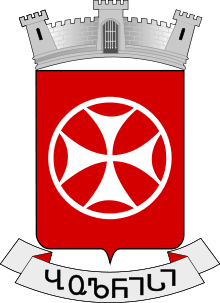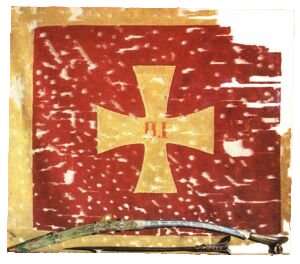Cross pattée

A cross pattée (or "cross patty", known also as "cross formée/formy") is a type of cross which has arms narrow at the center, and often flared in a curve or straight line shape, to be broader at the perimeter. The form appears very early in medieval art, for example in a metalwork treasure binding given to Monza Cathedral by Queen Theodelinda (d. 628), and the 8th century lower cover of the Lindau Gospels in the Morgan Library. An early English example from the start of the age of heraldry proper (i.e. about 1200) is found in the arms of Baron Berkeley.
Etymology
The word pattée is a French adjective in the feminine form used in its full context as la croix pattée, meaning literally "footed cross", from the noun patte, meaning foot, generally that of an animal.[1] The cross has 4 splayed feet, each akin to the foot, for example, of a chalice or candelabrum. In German it is called Tatzenkreuz from Tatze, foot, paw. Planché provides a dubious suggestion that the term comes from the Latin verb pateo, to lie open, be spread. He states it to be discernible on the standard of King Stephen (1135–1154).[2]
Variants
Several variants exist as follows:
-

With the edges of the arms concave throughout; the "Iron Cross", as generally used on Luftstreitkräfte aircraft in 1915
-

With less curvature, used on Luftstreitkräfte aircraft into April 1918, and the basis for the similar cross by the Bundeswehr of modern Germany
-

Bolnisi cross, official national symbol of the republic of Georgia, used on flag, coat of arms and various official and unofficial organizations of this country.
-

With the ends of the arms convex and curved; sometimes called "Alisee" (French croix pattée alésée arrondie)
-

With triangular arms which come close to filling the square
-

With triangular arms that do not fill the square (see also variation of the St George's cross)
-

With straight parallel lines at the centre (considered pattée by Rudolf Koch in Book of Signs)
-

Portuguese Military Order of Christ, a religious and military order founded in 1319 by King Denis I of Portugal
Use in crowns
Many crowns worn by monarchs have jewelled crosses pattée mounted atop the band. Most crowns possess at least four such crosses, from which the half arches rise. Some crowns are designed so that the half-arches can be detached, allowing the circlet to be worn separately on occasion.
A cross pattée is particularly associated with crowns in Christian countries. It is often heavily jewelled, with diamonds and precious stones. The Koh-i-Noor diamond is set in a cross pattée on the Crown of Queen Elizabeth (Elizabeth Bowes-Lyon). The British Imperial State Crown has a base of four crosses pattée alternating with four fleurs-de-lis. A cross pattée on the Imperial State Crown holds the Black Prince's Ruby. The cross pattée also features in many of the other British Crowns including the St Edward's Crown, used for coronations, and the Imperial Crown of India created for George V as Emperor of India to wear at the Delhi Durbar of 1911.
Use by Crusaders, Prussia and Germany
Teutonic Knights
This cross is often associated with the Crusades. The heraldic cross pattée was sometimes used by the Teutonic Knights, a Crusader order, though their more usual emblem was a plain straight black cross on white,.
Iron Cross

In 1813, King Frederick William III of Prussia established the Iron Cross as a decoration for military valor. It remained in use as a military decoration, in various forms, by Prussia and later Germany until 1945.
Prussian and German Imperial Landwehr and Landsturm troops used a Cross Pattée cap badge to distinguish them from regular army troops. A stylized version of the Cross Pattée is used by the modern German military (Bundeswehr) as its symbol of nationality, and is found on vehicles, aircraft and publications, with no border of any kind at the ends of each arm, much like the March/April 1918-May 1945 Balkenkreuz used.
Knights Templar
The cross pattée is sometimes associated with another Crusader order, the Knights Templar, though as with the Teutonic Knights, it was not used consistently. The Templars did adopt a red cross on their white robes in 1147,[3] but there was no specific style designated, and different Templars used different versions of the cross. The cross pattée was by no means their official symbol. Some modern Freemason organizations do use the cross pattée in an official way, and this use occasionally causes confusion as to which version was used by the medieval order of Knights Templar .
Georgia
The Bolnisi cross (Georgian: ბოლნისის ჯვარი bolnisis ǰvari) is a cross symbol, taken from a 5th-century ornament at the Bolnisi Sioni church, which came to be used as one of the oldest national symbol of Georgia. its is used on Flag and coat of arms of republic of Georgia and various organizations and administrative divisions within.
-
Bolnisi Sioni inscriptions. Oldest Georgian inscription that uses Georgian alphabet inside Georgia.
-

Flag of Republic of Georgia
-

Coat of Arms of Republic of Georgia
-

Ministry of defense of Georgia
-

Coat of Arms of city Bolnisi
Montenegro
The Montenegrin Cross flag (Montenegrin: Krstaš barjak) has been used in Montenegro since medieval times to represent clans, state, and lately its military divisions. The earliest documented use of this flag has been recorded in 1687,.[4][5] During the 1990s, it has been used as a symbol of Montenegrin independence movement, most notably by the Liberal Alliance of Montenegro. Nowadays, Montenegro's Royal Capital City Cetinje uses krstaš flag as its flag. It is also used as an unofficial alternate Montenegrin flag, as well as by local trademarks and societies related to Montenegro.
-

Flag of the Prince-Bishopric of Montenegro (pre 19th century)
-

Flag of the Montenegrin clans
-

Earlier version of Prince-Bishopric flag
-

Montenegrin flag used in the Battle of Vučji Do, damaged by Ottoman soldiers' bullets. The Н.I. initials indicate Prince Nicholas I. One of the most important historical Montenegrin flags.
-

Flag of Old Royal Capital Cetinje
-

Coat of arms of Nikšić Municipality
-

Flag of Montenegrins of Serbia
Other uses
The cross pattée is also placed before the name of the bishop who issues a Catholic imprimatur, and is occasionally found as a map symbol indicating the location of a Christian site.
It appears in the emblem of:
- The Victoria Cross.
- The Distinguished Flying Cross (United States)
- F.C. Paços de Ferreira, a Portuguese football club.
- C.F. Os Belenenses, a Lisboeta football club.
- The Sir Knight, Geneva Glen Camp's Highest rank in the orders
- The Knights of Columbus, designed in 1883, and called a "cross formée"
- Independent Truck Company, a manufacturer of skating equipment (in the alisée form, with the ends of the arms in the shape of arcs of an enclosing circle).
- The Crossmen Drum and Bugle Corps.
- Schneider Cams, a speed equipment manufacturer.
- Club de Regatas Vasco da Gama, a Brazilian sports club.
- Neath RFC, a rugby team.
- FC Volyn Lutsk, a Ukrainian football club.
- Black Label Society, a heavy metal band
It is also associated with the Alpha Tau Omega Fraternity.
Derivatives of the cross pattée are popular amongst bikers, hot rodders and metalheads.
Firefighters, especially in the United States, commonly use a version with triangular arms for patches and medals, though the cross pattée and the cross of St. Florian are both commonly mistaken for the Maltese cross. The cross pattée is used on the Marksmanship Badge in the United States Army, and United States Marine Corps.
Encoding
In Unicode, a Cross pattée character is encoded under the name "Maltese Cross" in the Dingbats range at codepoint U+2720 (✠).
The character "X" is rendered as a cross pattée in the Microsoft Wingdings font.
See also
References
- ↑ Larousse Dictionnaire de la Langue Francaise Lexis, Paris, 1993, p.1356
- ↑ Planché, J.R. The Pursuivant of Arms; or Heraldry Founded upon Facts. London, 1859, p.29
- ↑ Barber, Malcolm. The New Knighthood: A History of the Order of the Temple. Cambridge University Press, 1994. p.66 ISBN 0-521-42041-5
- ↑ Cetinje, Official website. "Simboli". Retrieved 18 April 2014.
- ↑ Cetinje, Official website (English). "Symbols". Retrieved 18 April 2014.
Weblinks
| Wikimedia Commons has media related to Cross pattée. |